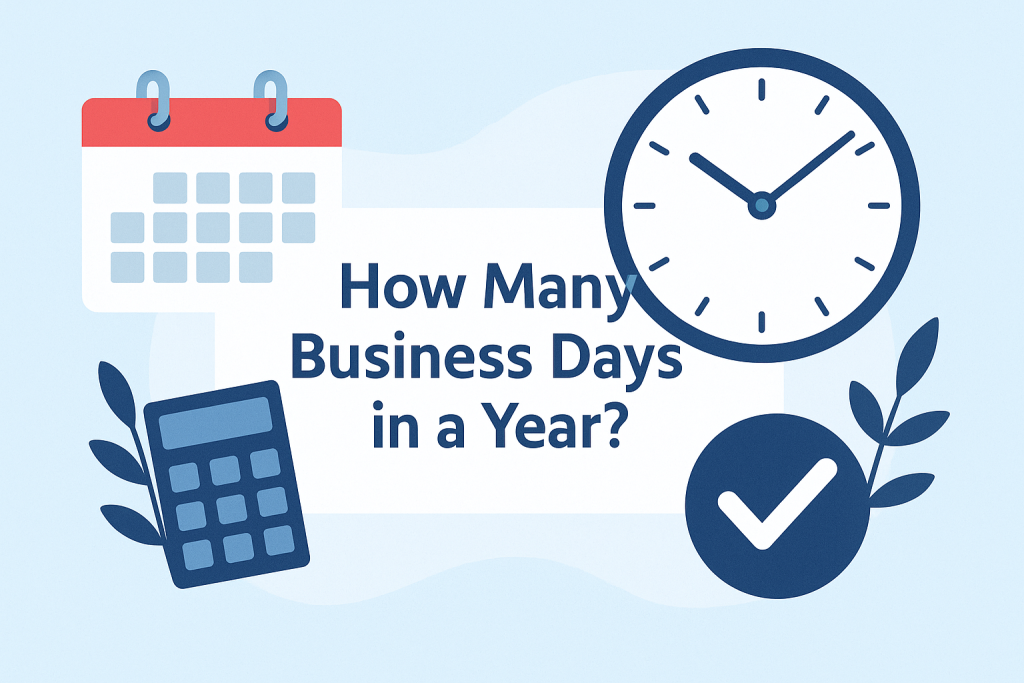Understanding Business Days: Why They Matter
In today’s fast-paced business world, knowing how many business days are in a year is essential for everything from project planning and payroll to vacation scheduling and contract deadlines. Business days typically refer to weekdays—Monday through Friday—excluding holidays. Understanding this calculation is crucial for accurate forecasting and smooth operations, whether you’re running a small business, managing HR, or planning personal projects.
Business days are used by countless industries as a standard for timelines, payments, and deliveries. Financial institutions, government agencies, and international companies all rely on business days to set expectations and formalize commitments. For individuals, knowing business days helps with everything from job interviews to planning vacations and understanding official deadlines.
In this comprehensive guide, we’ll break down exactly how many business days are in a year in 2024, explain the methods of calculation, explore factors that impact business day counts, and offer practical tips for maximizing productivity around your work calendar.
How to Calculate Business Days in a Year
The calculation of business days in a year is more nuanced than simply subtracting weekends. You must also consider public holidays, which can vary by country, state, or even company policy. Here’s a step-by-step method to determine the exact count:
- Identify Total Days: A standard year has 365 days; a leap year has 366.
- Subtract Weekends: There are typically 52 weeks in a year, which means 104 weekend days (52 Saturdays + 52 Sundays).
- Subtract Public Holidays: The number of recognized non-working holidays differs by region. In the United States, there are usually 10 federal holidays, but some companies might observe more or less.
Using these steps, you can tailor the calculation to your specific region or organization.
Example: Calculating U.S. Business Days in 2024
Let’s walk through the calculation for 2024, a leap year, in the United States:
- Leap Year: 366 total days
- Weekends: 52 weeks x 2 = 104 days
- U.S. Federal Holidays (most fall on weekdays): 10 days
So, 366 – 104 – 10 = 252 business days in 2024 for most U.S. federal workers. This number can vary if a holiday falls on a weekend or if your organization observes additional holidays.
Factors That Affect the Number of Business Days
While the standard method offers a useful estimate, several factors can influence the actual number of business days in a given year. Being aware of these can help you plan more effectively and avoid surprises.
Leap Years vs. Regular Years
Leap years add an extra day (February 29), which may shift the distribution of days and slightly alter the count of business days because the year contains one additional day that could be a weekday or a weekend. For example, 2024 is a leap year, impacting the calculation compared to a typical 365-day year.
Public and Regional Holidays
Not all holidays are observed nationwide. Some states or local governments may recognize additional holidays, and certain businesses may offer extra days off. As a result, the number of business days can vary based on your location and employer’s policy.
Company-Specific Days Off
Many organizations provide extra paid time off, such as company-wide mental health days, floating holidays, or additional end-of-year closures. Always check your company’s official calendar to account for these unique non-working days.
Business Days in Major Countries: A Quick Reference
While the focus here is on the U.S., let’s look at business day norms in a few other major countries. This comparison is especially helpful for international businesses or those working with global clients.
- United States: 250–253 business days, depending on the year and holiday observance
- United Kingdom: Approximately 252 business days, accounting for 8 bank holidays
- Canada: Around 251 business days, with 9-10 statutory holidays on average
- Australia: About 249 business days, factoring in national and state holidays
- Germany: 250–255 business days, varying widely by state due to local holidays
Always consult a current calendar for your region to get the most precise count.
Why Knowing the Number of Business Days Is Important
Understanding business days is more than a matter of curiosity. This knowledge plays a critical role in project management, financial planning, and compliance with legal or contractual obligations. Here’s why it matters:
- Project Management: Accurate scheduling prevents missed deadlines and improves client satisfaction.
- Payroll Processing: Many companies tie paid leave, sick days, or payroll cycles to business days rather than calendar days.
- Contract Fulfillment: Legal documents often specify “business days” for delivery, response, and penalty clauses.
- International Coordination: Understanding business days in different countries ensures smooth collaboration across time zones and holidays.
Practical Examples
Say you’re launching a marketing campaign that runs for 100 business days, or you’re planning a long-term construction project. Having an accurate business day count allows you to forecast timelines, manage resources, and set realistic expectations for everyone involved.
Tips for Planning Around Business Days and Holidays
Maximizing productivity and minimizing disruptions requires careful planning around business days. Here are some practical strategies:
- Use Updated Business Calendars: Online tools and apps like Google Calendar or Outlook allow you to add public holidays and customize non-working days.
- Double-Check International Dates: When working with global clients, always clarify which holidays and weekends are observed in their region.
- Plan for Holiday Impact: Avoid scheduling major project milestones right after extended holiday periods, when productivity may be lower.
- Set Clear Internal Policies: Make sure your team understands which days are considered business days, especially concerning flexible work arrangements or remote work.
- Automate Repetitive Calculations: Use spreadsheet formulas or business day calculators to save time and reduce errors in scheduling.
Business Days Calculator: How to Make It Work for You
Several free and paid online tools can help you calculate business days between any two dates, factoring in weekends and holidays. These calculators are essential for HR professionals, project managers, and anyone who needs to plan ahead with confidence.
Popular Tools and Methods
- Online Calculators: Websites like Timeanddate.com or CalculatorSoup provide easy-to-use business day calculators.
- Spreadsheet Functions: Excel’s NETWORKDAYS and NETWORKDAYS.INTL functions let you automate calculations within your project tracking sheets.
- Custom Applications: Some organizations build internal tools to reflect unique company calendars and holidays.
These solutions not only save time but also reduce the risk of oversight when working with complex schedules.
Frequently Asked Questions About Business Days in a Year
Are Business Days Always Monday to Friday?
In most countries, business days are indeed Monday through Friday. However, there are exceptions. For example, in some Middle Eastern countries, the standard workweek runs from Sunday to Thursday, making Friday and Saturday the weekend. Always check local customs if working internationally.
Do All Companies Observe the Same Holidays?
No, holidays can vary significantly across companies and regions. Some organizations observe additional holidays beyond the national minimum, such as cultural or religious observances, while others may offer fewer days off. Always consult your company’s official holiday calendar for precise planning.
How Can I Convert Calendar Days to Business Days?
The simplest way is to use an online business day calculator or spreadsheet formula. Subtract weekends and company-observed holidays from your total date range to arrive at the correct number of business days.
Conclusion: Mastering Your Work Year With Accurate Business Days
Knowing how many business days are in a year is a surprisingly powerful piece of information. It helps you manage projects, plan finances, meet deadlines, and communicate clearly with clients and coworkers. In 2024, the U.S. has approximately 252 business days, but this can vary depending on holidays and specific organizational practices.
For the best results, always confirm with your organization’s official calendar and leverage modern tools to streamline your business day calculations. Proper planning around business days ensures you work smarter, achieve more, and minimize costly surprises throughout the year.


